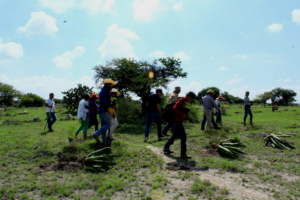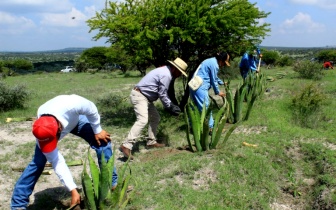Reforestation work carried out in San Miguel de Allende
News Category: News and Community News
-
The improvement of the ecosystem in San Miguel de Allende is taking place with the reforestation work carried out by the Environmental and Sustainability Department.
Coordinating efforts on this occasion with the National Forestry Commission, the municipal Directorate of Environment and Sustainability continues planting trees in priority areas, to continue restoring the natural conditions of San Miguel’s soil and mitigating the effects of climate change.
This ecological project is called “Payment for Environmental Services” and is being carried out for 45 days on almost 100 hectares in the Los Torres community which, together with Tierra Blanca, Atotonilco, La Cieneguita, and neighboring localities, is part of the Cruz del Palmar micro-watershed and, in turn, is an upper part of the Laja River Basin; There, 60 thousand agave, ocotillo, and Palo dulce plants are being planted, with natural fertilizer from dried lirio, to directly benefit the 458 inhabitants of Los Torres and indirectly the entire area of the upper western part of the municipality.

“With these actions we retain nutrients, and water, increase the generation of oxygen, the absorption of carbon dioxide, optimize the ecosystem and use native plants that are easily adapted, recover the vegetation cover, reduce soil erosion and somehow combat the problem we have in the (Allende) dam: all the nutrients that are carried from the upper basin reach this body (of water). We are using dry lirio, as in urban forests, for moisture retention, water affectation to the subsoil and naturally, it is going to degrade to end up as fertilizer to support in the planting and establishment of these individuals,” expressed the director of Environment and Sustainability, Alejandro Castro.
Allocating more than $700 thousand pesos ($757 684.00) of concurrent public resources, 46 families from this rural locality were employed, with whom productive value chains are being created in the medium term, mainly by planting agave.
In this sense, Alejandro Castro emphasized that “we are doing it to regenerate that part of the ecosystem, to recover the soil in that part and we are also supporting the ejidatarios to maintain their land. In the future, this could lead to a productive chain project; the agave industry is very noble in this sense, although it takes between 5 and 6 years to reap its first benefits. A technical advisor is hired and all he does is supervise the scientific part, the physical execution, and the work done by the ejido, through these families, they do the digging, planting, they go to place the lily, transporting the plant and many of them even provide plants or seeds that they themselves have produced. So it becomes a circular economy.
Previously and on its own, the Municipal Government has already intervened in the natural area of the Tierra Blanca community, also in the west of San Miguel, and soon in Cruz del Palmar, with reforestation and soil rescue actions.
Following the collaboration with the federal agency, the next area to intervene will be in El Salitre, where a similar reforestation intervention is already planned, although with a smaller amount of plants and resources applied; however, it is required to be during the rainy season, since if the growth period of the plants is exceeded, the drought period is maintained in the region and also the low temperatures of autumn and winter arrive, the probability that the plants will be preserved after freezing weather decreases considerably.
-


Leave a Reply